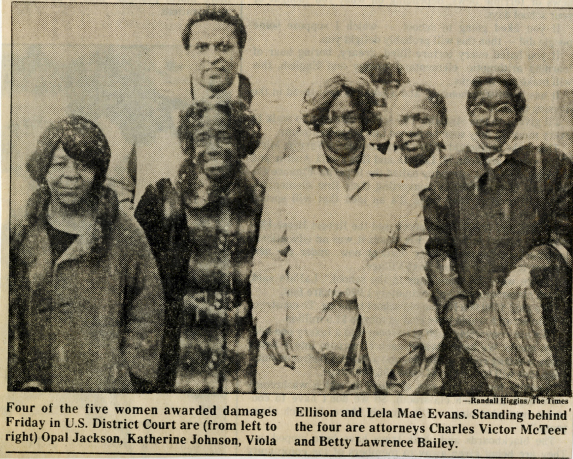It is time we memorialize the five Chattanoogans - five African American women - shot in an act of domestic terrorism in 1980.
Our city has memorialized others: Confederate generals, police officers, veterans, Medal of Honor recipients, the Fallen Five.
Now, it is time we create a memorial for these black women: their bravery, their struggle, their victory over hate.
Viola Ellison.
Lela Evans.
Fannie Mae Crumsey.
Katherine Johnson.
And Opal Lee Jackson.
In April 1980, these five women were shot - four shot, one shot at - in downtown Chattanooga by three Klansmen who shotgunned them for one reason: their skin.
The men were acquitted, yet the women, undaunted, later won a hallmark civil case against the Klan.
Today, the women are deceased.
Except one.
Thursday evening, Opal Lee Jackson slowly stood up from her table at the Bessie Smith Cultural Center, where a standing-room-only crowd, gathered for the event "Black Heroines for Justice," gave her what was long overdue:
An embracing standing ovation.
"This is a story that needs to be told here," said Randolph McLaughlin, the New York City attorney who represented the women.
In 1982, a civil court awarded them $535,000; while they never received much, if any, of that money, the case created a new legal strategy - a defensive wall of injunctions between the Klan and black Chattanooga - later used across the nation.
At Thursday's event, McLaughlin, illuminating and acute, spoke about events then and now.
The re-emerging Klan in the 80s.
The re-emerging Klan today.
Our state's devotion to memorializing Confederate leaders, but not black heroes.
"And there's not one memorial in this city for these women?" he said.
He knows where we should built it.
"The corner of Ninth and Douglas," he said. "Right where they got shot."
In April 1980, Bill Church, Marshall Thrash and Larry Payne drove down Ninth Street - now M.L. King Boulevard - carrying two shotguns, dozens of shells and a letter Church - an avowed Klansman - had written about a race war.
It reads like a mass shooting manifesto.
"Until the war starts or the Klan has violence of its own - I've started my own move against the damn n --!" he wrote.
After trying to burn a 2x4 cross under the train tracks, the men drove down Ninth Street. As the four women exited a nightclub, Thrash fired. (Fannie Mae Crumsey, in her front yard, was shot at moments later.)
Arrested, the men were charged: felonious assault with intent to commit murder.
During jury selection, defense lawyers challenged, or eliminated, possible black jurors, because of color.
In July 1980, the white jury acquitted the white men. (Thrash, guilty of a lesser sentence, served less than four months in jail.)
Last Sunday, I wrote about this. Multiple readers responded, saying the same thing.
Blame the district attorney.
Not the jury.
"Bird shot," one reader said.
Reportedly, the Klansmen used bird shot, not buck shot, which creates a wider pellet pattern and is theoretically less lethal.
The DA's intent-to-murder charge was therefore inappropriate.
"It was obvious that the shooters meant to inflict harm, but not kill," one reader said.
Another reader reportedly knew a juror.
"He told me they acknowledged what the men had done but the DA had gone for attempted first-degree murder, which they saw clearly not to be the situation. Therefore they had no choice but to acquit," the reader said.
Three things come to mind.
Are there jurors who feel remorse over the acquittal?
Did jurors feel pressure to go against their conscience?
Who says bird shot can't kill?
Used with murderous intent, a butter knife can kill. Church was an avowed racist Klan leader. You think he only wanted to dust up a little bird shot on these black women? (Side note: that race war letter? It was never introduced as evidence in the trial.)
The Bird Shot Excuse hazes over the core truth:
Black women in our city were shotgunned by white Klansmen.
End of story.
Imagine three black men shooting five white women as they walked out of a downtown restaurant.
Think an all-white Chattanooga jury would acquit them?
"Truth and justice will reign if we keep the conversation alive," Tiffany Herron said Thursday night.
Herron, a University of Tennessee at Chattanooga graduate student, created Thursday's event. She's researching in hopes of writing a novella about these women.
Yes, this story is well known in black Chattanooga.
But white Chattanooga? Why have we been asleep to this?
One final point: When McLaughlin tried this case on the third floor of the Joel W. Solomon federal building, he remembers a courtroom mural depicting the long-ago South - proud Confederate soldiers, white women, white farmers, white frontiersmen.
And stooped black folks picking cotton.
"Is it still there?" he asked me, last week.
No, I replied. Surely not.
Thursday, McLaughlin went to see for himself.
Friday, I did, too.
And there the mural hangs.
Called the "Allegory of Chattanooga", the mural - 18 feet long, painted in the 1930s - depicts 21 Chattanoogans; 18 of them are white. Two native Americans - painted in the most stereotypical of ways - stand near one black man, who bends low, placidly picking cotton in a sack.
In our federal courtroom, where justice is blind and all men and women equal, a mural hangs depicting and nostalgically celebrating slavery.
It is outlandishly whitewashed history.
It's time to take the mural down.
Let's build a memorial for these five women in its place.
David Cook writes a Sunday column and can be reached at dcook@timesfreepress.com.


